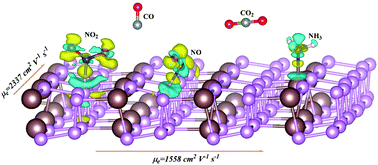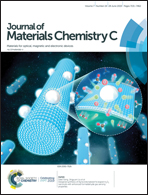A novel two-dimensional δ-InP3 monolayer with high stability, tunable bandgap, high carrier mobility, and gas sensing of NO2†
Abstract
Based on ab initio density functional theory calculations and by using the global optimization algorithm, we propose a novel two-dimensional (2D) InP3 allotrope (δ-InP3 monolayer), which has much lower formation energy and exfoliation energy than those of the earlier known β-InP3 monolayers. The δ-InP3 monolayer has an indirect bandgap of 0.51 eV, which could be easily tunable by adjusting the strains along the a direction. Our calculations reveal that this new InP3 allotrope exhibits worthwhile anisotropy along with high electron carrier mobility. The electron mobility of the δ-InP3 monolayer can reach up to 2741 and 1751 cm2 V−1 s−1 along the a and b directions, respectively. The absorption coefficients for the δ-InP3 monolayer and bilayer are predicted up to the order of ∼106 cm−1 in the entire visible region. More interestingly, the calculated results show that the δ-InP3 monolayer is a promising N-based gas sensor (particularly for NO2 molecules), with high selectivity, sensitivity, and good reversibility.



 Please wait while we load your content...
Please wait while we load your content...